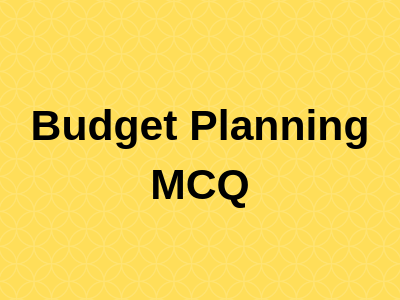1. Budgets perform the function of:
a. Predicting interest rates.
b. Determining a firm’s sustainable rate of growth.
c. Providing the basis for taking corrective action.
d. Calculating plowback ratios.
ANS:- c
2. Which of the following items would NOT be included in the cash budget?
A. Depreciation charges
B. Payments to suppliers
C. Cash receipts
D. Taxes
ANS:- a
3. A flexible budget differs from a fixed budget in that more than one set of input values for variables such as Sales are used.
a. True
b. False
ANS:- a
4. Which of the following would be classified as spontaneous liabilities?
A. Accounts receivable
B. Accounts payable
C. Notes payable
D. Long-term debt
ANS:- b
5. Which of the following would decrease the need for additional discretionary financing, everything else constant?
a. The firm anticipated higher sales growth.
b. The firm’s net profit margin was lower.
c. The firm paid a higher percentage of earnings out as cash dividends.
d. The firm retained a higher percentage of earnings.
ANS:- d
6. A firm’s sustainable rate of growth (g*) is determined by which of the following :
a. g* = ROE(1 – b).
b. g* = net income/common equity.
c. g* = sales/assets.
d. g* = common equity/assets.
ANS:- a
7. The presence of excess capacity increases the need for discretionary financing for any level of sales increase.
A. True
B. False
ANS:- b
8. If there exist economies of scale in inventory investment, the percent of sales method is likely to overstate additional asset needs for a given increase in sales .
a. True
b. False
ANS:- a
9. At the sustainable rate of growth, the company does not need any additional assets to support the increased sales.
A. True
B. False
ANS:- b
10. Which of the following work to automatically reduce the need for discretionary financing as sales increase?
a. Increases in spontaneous liabilities
b. Increases in retained earnings
c. Increases in fixed assets
d. Both a and b above
ANS:- d
BUDGET PLANNING Objective Questions Pdf Free Download::
11. A firm is using the DFN model to forecast the additional capital that they need to raise because of a sales increase. Which of the following factors are likely to increase the DFN?
a. The firm has a lot of excess capacity.
b. The firm has a high dividend payout ratio.
c. The firm has a lot of spontaneous liabilities that increase as sales increase.
d. The firm has a high-profit margin.
ANS:- b
12. The first step involved in predicting financing needs is:
a. project the firm’s sales revenues and expenses over the planning period.
b. estimating the levels of investment in current and fixed assets that are necessary to support the projected sales.
c. determining the firm’s financing needs throughout the planning period.
d. estimating the firm’s DFN.
ANS:- a
13. The Stuff Antique Store has current sales of $12 million and predicts next year’s sales will grow to $16 million. Current assets are $3 million and fixed assets are $4 million. The firm’s net profit margin is 6 percent after taxes. Presently, Stuff has $800,000 in accounts payable, $1.1 million in long-term debt, and $5 million (including $2.5 million in retained earnings) in common equity. Next year, Stuff projects that current assets and liabilities will rise in direct proportion to the forecasted sales, and that fixed assets will rise by $600,000. The Stuff Antique Store plans to pay dividends of $400,000 to common shareholders. What are Stuff’s total financing needs and discretionary financing needs for the upcoming year?
A. $8.6 million and $.27 million.
B. $7.5 million and $.25 million.
C. $6.5 million and $.15 million.
D. $5.5 million and $.45 million.
ANS:- a
14. To determine the number of discretionary funds needed, you would subtract the expected increase in liabilities from the sum of the expected increases in retained earnings and assets.
a. True
b. False
ANS:- b
15. Accounts payable represent a spontaneous form of financing for a firm.
A. True
B. False
ANS:- a
16. The process of planning future business actions and expressing those plans in a formal manner, usually in monetary terms, is called budgeting.
A. True
B. False
ANS:- A
17. The budgeting process can be used to promote a positive effect on employees’ attitudes, but it can also yield a negative one.
A. True
B. False
ANS:- a
18. The task of preparing the budget normally is the responsibility of one department, the controller’s department or a department of one of the high-level managers.
A. True
B. False
ANS:- B
19. Most successful businesses generally prepare their budgets from ‘the top down’. These budgets are tightly controlled by upper management .
A. True
B. False
ANS:- B
20. Since the budget period normally coincides with the accounting period, budgets of less than one year or greater than one year are not normally prepared.
A. True
B. False
ANS:- B
21. Which of the following is NOT true about the Master Budget?
a. It is composed of many interrelated budgets.
b. It consists of 2 classes of budgets: Operating Budgets and Financial Budgets.
c. Within the master budget, the first budget to be prepared is the sales budget.
d. It constitutes a plan of action for a specified period of time.
e. All of the above are true.
ANS:- E
22. The Willsey Merchandise Company has budgeted $40,000 in sales for the month of December. The company’s cost of goods sold is 30% of sales. If the company has budgeted to purchase $18,000 in merchandise during December, then the budgeted change in inventory levels over the month of December is:
A. $ 6,000 increase.
B. $10,000 decrease.
C. $22,000 decrease.
D. $15,000 increase.
ANS:- A

